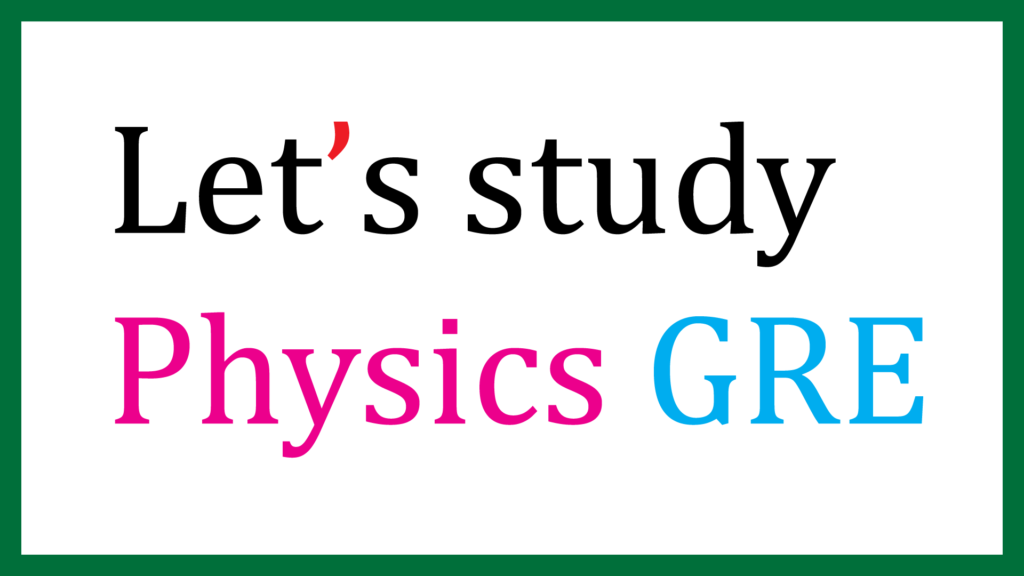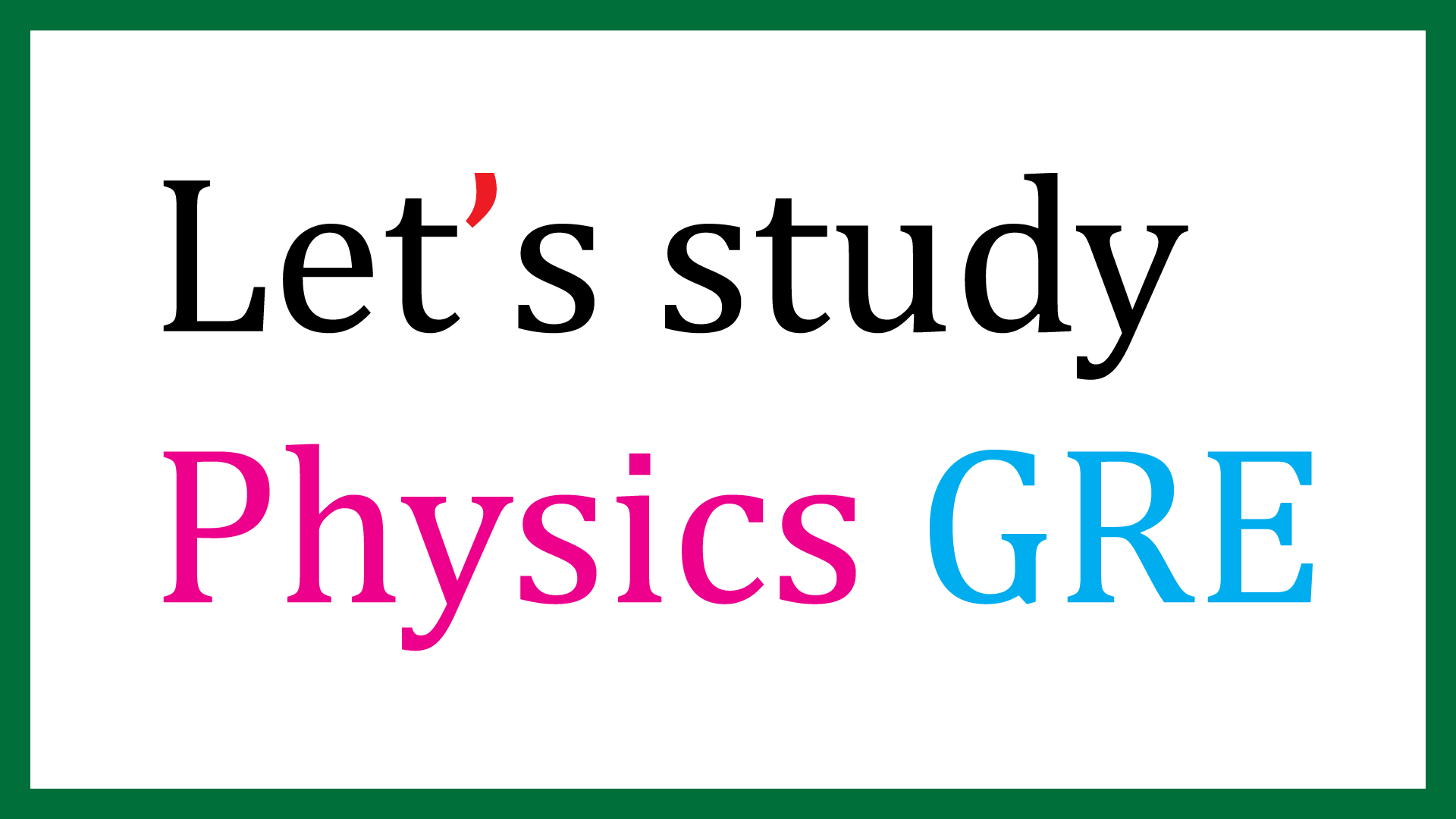
CLASSICAL MECHANICS — 20%
PGRE1777(1,2,3,17,18,19,46,47,48,49,64,65,66,67,79,80,87,88,89,90,97)
PGRE9677(5,6,7,8,20,21,22,23,30,31,32,44,65,66,68,84,92,93)
PGRE9277(4,5,6,7,8,19,40,41,42,43,44,45,61,66,74,78,82,87,93,100)
PGRE8677(1,2,4,5,6,7,8,34,35,36,37,43,44,60,61,62,75,76,77,93,97)
PGRE0177(1,2,3,4,22,23,24,25,26,54,55,56,57,72,73,74,75,89,90,91,92)
Kinematics
Newton’s laws
Work and Energy
Oscillatory Motion
Rotational motion about a fixed axis
dynamics of systems of particles
central forces and celestial mechanics
three-dimensional particle dynamics
Lagrangian and Hamiltonian formalism
Non inertial reference frames
elementary topics in fluid dynamics
- ELECTROMAGNETISM — 18%
PGRE1777(4,5,6,20,21,37,38,39,40,68,69,76,77,78,94,95,96)
PGRE9677(1,2,3,4,24,25,26,28,43,45,46,47,49,54,55,61,62,69,70,71,86,87,88,89)
PGRE9277(9,10,11,12,13,18,32,33,34,36,39,54,55,57,60,64,65,81,83,84,86,88,92)
PGRE8677(9,10,11,22,24,25,29,38,39,52,53,54,63,64,65,78,79,80,81,86,94,98)
PGRE0177(7,8,9,10,38,39,40,41,42,58,59,60,61,62,85,86,87,88,95,96)
electrostatics
currents and DC circuits
magnetic fields in free space
Lorentz force
induction
Maxwell’s equations and their applications
electromagnetic waves
AC circuits
magnetic and electric fields in matter
- OPTICS AND WAVE PHENOMENA — 9%
PGRE1777(15,16,30,31,32,50,51,52,81,82)
PGRE9677(56,57,58,82)
PGRE9277(20,21,22,35,67,68,69,79)
PGRE8677(13,58,73,74,100)
PGRE0177(11,12,13,51,69,70,96,97,100)
properties
superposition
interference
diffraction
geometrical optics
polarization
Doppler effect
- THERMODYNAMICS AND STATISTICAL MECHANICS — 10%
PGRE1777(7,8,9,28,29,56,57,58,91)
PGRE9677(13,14,15,16,73,74,75,79,91,94,95)
PGRE9277(14,15,16,23,46,47,62,63,71,72,73)
PGRE8677(14,15,46,51,55,66,67,87,88,95)
PGRE0177(5,6,35,36,37,47,48,49,63,65,76,77,98)
the laws of thermodynamics
thermodynamic processes
equations of state
ideal gases
kinetic theory
ensembles
statistical concepts and calculation of thermodynamic quantities
thermal expansion and heat transfer
- QUANTUM MECHANICS — 12%
PGRE1777(12,13,25,26,43,44,45,61,62,63,70,71,92,99)
PGRE9677(17,18,29,33,35,39,41,42,51,52,59,76,77,97,98,99,100)
PGRE9277(1,27,28,29,50,51,52,53,56,89,90,98,99)
PGRE8677(18,19,28,49,56,57,89,90,92,96)
PGRE0177(27,28,29,30,43,44,45,46,81,82,83,93,94)
fundamental concepts
solutions of the Schrödinger equation
(including square wells
harmonic oscillators
and hydrogenic atoms)
spin
angular momentum
wave function symmetry
elementary perturbation theory
- ATOMIC PHYSICS — 10%
PGRE1777(22,23,24)
properties of electrons
Bohr model
energy quantization
atomic structure
atomic spectra
selection rules
black-body radiation
x-rays
atoms in electric and magnetic fields
- SPECIAL RELATIVITY — 6%
PGRE1777(34,35,36,53,84,85,93)
PGRE9677(36,37,38,48,49,50,60,67)
PGRE9277(37,38,70,85,94,96,97)
PGRE8677(3,20,21,22,68,69,70,71,72)
PGRE0177(32,33,34,71,79,80,99)
introductory concepts
time dilation
length contraction
simultaneity
energy and momentum
four-vectors and Lorentz transformation
velocity addition
- LABORATORY METHODS — 6%
PGRE1777(14,42,54)
data and error analysis
electronics
instrumentation
radiation detection
counting statistics
interaction of charged particles with matter
lasers and optical interferometers
dimensional analysis
fundamental applications of probability and statistics
- SPECIALIZED TOPICS — 9%
PGRE1777(10,27,33,55,59,60,72,73,74,75,83,86,98)
Condensed matter
PGRE9677(78)
PGRE8677(23,51)
PGRE0177(5253)
PGRE9277(97)
Nuclear and Particle Physics
PGRE9677(9,10,11,12,19,34,40,42,53,63,64)
PGRE9277(23,24,25,26,30,31,49,58,59,75,76,77,80,90,95)
PGRE8677(1619262730313233404142454748828384859199)
PGRE0177(1417181920213164666768788491)
Nuclear and Particle physics
(e.g., nuclear properties
radioactive decay
fission and fusion
reactions
fundamental properties of elementary particles)
Condensed Matter
(e.g., crystal structure
x-ray diffraction
thermal properties
electron theory of metals
semiconductors
superconductors)
Miscellaneous
(e.g., astrophysics
mathematical methods
computer applications)
